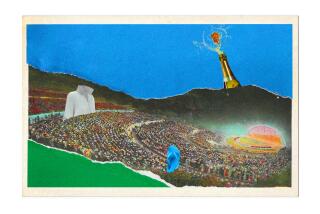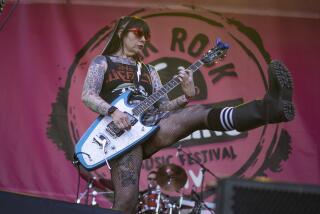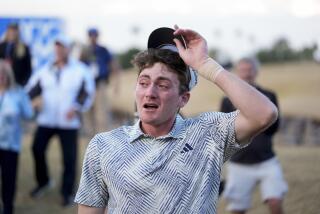He Hopes to Follow PBA Out of Gutter
Editor’s note: Times staff writer Thomas H. Maugh II, an amateur bowler who competes in four leagues, is trying to qualify for the U.S. Open, a Professional Bowlers Assn. tour event underway this week at Fountain Bowl in Fountain Valley.
I bowled a 120 game Wednesday.
I can’t tell you the last time I bowled such a low score -- it has been much too long.
The only thing that saved Wednesday’s 120 from being completely humiliating was that some other people at the PBA U.S. Open did just as badly.
I was lucky to even be bowling here at all. The PBA nearly went out of business.
Three years ago, the Professional Bowlers Assn. was unable to meet its next payroll, facing bankruptcy court and on the verge of extinction.
Then retired Microsoft entrepreneur Chris Peters and two colleagues bought the PBA lock, stock and bowlers and set about reviving it. Peters had actually wanted to join the tour, but even with professional coaching and lots of practice, couldn’t quite hack it. I know exactly how he felt.
When that effort failed, he volunteered to serve on the PBA’s board of directors. Seeing the group’s dire financial straits, he brought in two other computer millionaires, Mike Slade of Starwave and Rob Glaser of Real Networks, and they bought PBA for $5 million. They have since put another $15 million into the organization to move headquarters to Seattle, boost prize funds, buy new equipment, produce the weekly television show and promote the sport.
Perhaps one of their smartest moves was to hire Steve Miller, the former head of sports marketing at Nike, as their president/chief executive. Under his leadership, the group is, if not exactly flourishing, at least making major headway. Membership is up, prize funds are up, and the tournament finals are now appearing live every week on ESPN. Miller expects the group to achieve profitability by March 2004.
“Bowling has gotten a really bad rep over the years” because of smoking, drinking and other factors, Miller said. “When you watch Fernando Valenzuela pitch, you don’t assume that all ballplayers are fat. But when people see a fat bowler, they make that leap that everyone is. People question whether it even is really a sport.”
Another “glaring issue is the perception of sports snobbery. Bowling is not played in country clubs, and not in front of 50,000 to 100,000 people.”
Sponsors are beginning to climb aboard the bandwagon. Three years ago, PBA had no full-time sponsors. Now, it has 13 -- including Jackson-Hewitt Tax Services, which sponsors this week’s open; Pepsi, Dr. Scholl’s, Days Inn and Miller Brewing Co. -- “and more are in the pipeline.”
PBA membership is at an all-time high, with more than 4,000 bowlers. At the time of the takeover, there were only 2,100.
The group was forced to reduce the number of tournaments from 33 a year to 20 each of the last two years. The number will grow somewhat next year, Miller said, and there are now 10 senior tournaments and 170 regional PBA tournaments.
Despite the shrinkage in tournament numbers, the prize fund has grown from $1.6 million before the takeover to $4.3 million this year. First prize in some tournaments used to be as low as $15,000. It’s now a minimum of $40,000, and it jumps to $100,000 in the majors, such as this week’s open.
“Money does make a difference in how the sport is perceived,” Miller said.
With the exception of last week’s Las Vegas Open, weekly finals have been broadcast live every Sunday morning on ESPN, and viewership has been climbing. Ratings had sunk below 0.5 but are now averaging close to 1.0, about double those of the NHL on cable, Miller said. “Last weekend, it was 1.48, which on a cable network is very good. That was better than the NBA for the weekend.”
One key improvement, he said, is that the number of 18- to 34-year-old males watching the show has quadrupled over the last year.
PBA produces the show, sells the ads, and splits the profits -- if any -- with ESPN. What no one will say is whether PBA pays ESPN to air the show.
PBA may be becoming a bigger success, but for me, Wednesday was pretty much of a disaster. I was cruising along at a strong mediocre for the first four games, but as the lane conditioner started evaporating and moving around, it got harder to make a good shot, and I imploded.
I shot 942 for six games, bringing my total for the tournament to minus-417 -- that is, 417 pins fewer than what I would have scored if I had averaged 200 every game. After two days of qualifying, I am 303rd out of 347.
The leaders are Ryan Shafer, plus 258; and Jason Duran, plus 232.
I didn’t expect to win, but I didn’t expect to do this poorly, either. It is difficult to appreciate the difficulty the pros face until you actually get out there on the lanes with them. I have one day left, and I am not sure I am looking forward to it.
More to Read
Go beyond the scoreboard
Get the latest on L.A.'s teams in the daily Sports Report newsletter.
You may occasionally receive promotional content from the Los Angeles Times.










